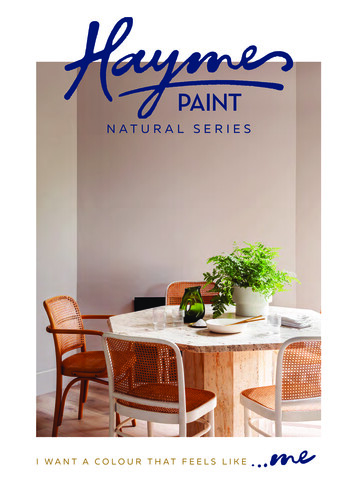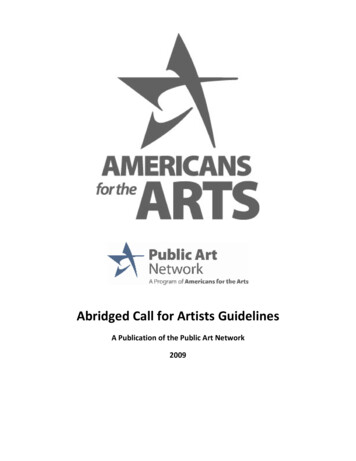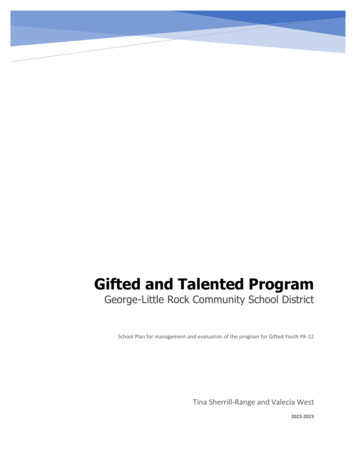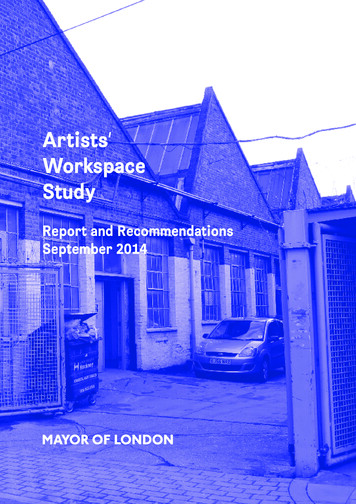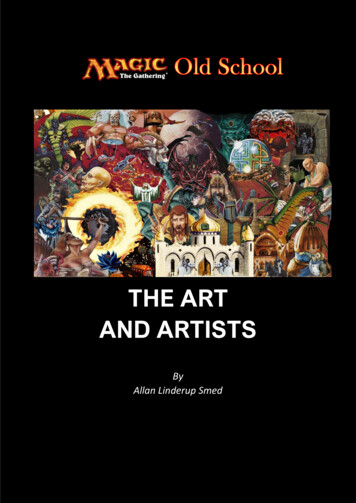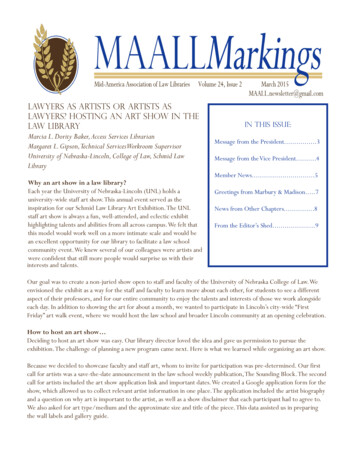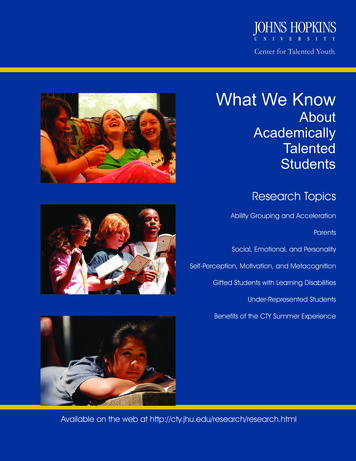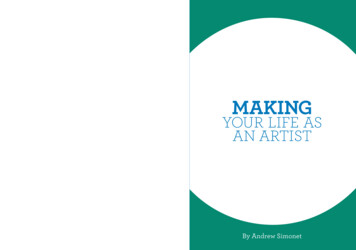
Transcription
Artists are the most talented,hard-working people I know.So why are they perennially exhausted,broke, and overwhelmed?Based on 20 years as a working artist anda decade of work with artists locally andnationally, Making Your Life as an Artist looksat why artists’ lives are so punishing, and howwe can build balanced, sustainable lives.This book is available as a free download(no strings attached) at artistsu.orgAndrew Simonet is a choreographer, writer, andfounder of Artists U, a grassroots planning and professionaldevelopment program for artists. He co-directedHeadlong Dance Theater from 1993 to 2013.MAKINGYOUR LIFE ASAN ARTIST
MAKINGYour Life as an Artist
MAKINGYour Life as an ArtistBy Andrew Simonet
The role of the artistOur punishing livesOur skillsPlanningMissionMoneyTimePrinciples
67
Thank8you9
Thank you for being an artist.10Thank you for making your work.11
Thank you for choosing this life whichcan be hard.And hard to explain.It is incredibly important that you are doing it.The culture needs you to do it and do it well.(Though the culture doesn’t always know that.)1213
Many people don’t understand what we do.“What’s your REAL job?”“Have you ever been (on the best sellerlist, on TV, at the one museum I’veheard of)?”The role artists play in culture is essential.But it isn’t well understood.So let’s start there.What do artists do?“I’m an artist, too! I like to (make tie-dyeshirts, do karaoke, brew beer)!”1415
This is why, after 20 years of working as anartist, my relatives still say things like:“How’s that little dance thingy coming?”A lot of people think of artists like athletes.“That must be so fun!”In sports, you have a tiny sliver ofprofessionals – the ones you see on TV.Professional basketball players are the realbasketball players.“Are you getting in good shape?”Anyone else who plays basketball does it asa hobby. It’s something you do after work.To them, dance is a hobby, not a profession.It’s not work, it’s something you do after work.Unless, of course, you get on TV.“When are you gonna dance on thatTV show?”This is completely wrong.1617
I think of artists like scientists.Just like scientists, we begin with a question,something we don’t know.We go into our studio and research thatquestion.1819
Like scientists, at the end of our research,we share the results with the public and withour peers.Just as in science, a negative result is asimportant as a positive result.Some research is “basic,” useful primarily toother researchers. Some is “applied,” relevantto everyday life.Finding that a certain drug does not curecancer is a crucial discovery. And an artisticexperiment that fails produces importantinformation.Both are essential. And most artists do someof both, creating experimental work thatpushes the form as well as work that is morebroadly relevant.When you are working beyond what is known,when you are questioning assumptions thathaven’t been questioned, you generate a lot ofuseful failure.Failure in science and art is a sign that theprocess is working.2021
Though certain scientists win the Nobel Prizeand get famous, all scientists know they arestanding on the shoulders of thousands ofresearchers all over the world who have beenasking questions.The scientific method and the artisticprocess are the two most robust problemsolving methodologies ever developed. Takeeither one away, and our world would beunrecognizable.And while some artists will get the fancyawards (and maybe even get on TV), weknow they are standing on the shoulders ofthousands of artists who have been doingartistic research for decades.Look around you: every object, every surface,every technology was created, refined, anddesigned using the scientific method and theartistic process.In art, as in science, there is an element offaith. Scientists don’t enter the lab saying,“I will cure cancer.” They say, “If I join thethousands of researchers asking rigorousquestions about cancer, discoveries andbreakthroughs will be made.” In science andin art, you cannot say in advance that thisexperiment will lead to this result.But we artists know that if we join thethousands of artists asking rigorousquestions, the world will change.It always has.2223
These two methods work on different things.The scientific method works on materialquestions. The artistic process works onquestions of culture, questions of thought.And today, especially in the “developedworld,” many of our toughest problems arequestions of thought and culture.Artists are the only people who contributenew knowledge to the cultural realm. Otherscan refine, popularize, or synthesize ourresearch, but we discover new culturalinformation.We live in a time when we are inundated byimages: pictures, language, videos, stories,music, bodies.99% of those images are made for one reason:to get you to buy something. We artists areresponsible for that tiny sliver of images thatcan be made for every other possible reason:cultural, spiritual, political, emotional.In an age of image overload, this is a sacredresponsibility.That is a sacred responsibility.2425
Sometimes I think of art like food.The Food Industry has decided that weshould eat a tiny handful of plants andanimals over and over. Corn, famously, isfound in a huge amount of American food.Highly refined byproducts of corn are addedto nearly everything, and the animals we eatmostly live on corn. They are even breedingsalmon who can eat corn.Similarly, the Entertainment IndustrialComplex has decided we should all consumethe same limited, repetitive cultural diet.Over and over, we see the same five stories.The same three bodies.The same four kinds of relationships.(Salmon don’t eat corn. Obviously.)2627
With food, there have long been seed saversand farmers who reject the standardization ofour diet. They grow things that don’t fit withindustrial agriculture. They preserve the seedsfor plants we may need someday.This is what artists do culturally. We providethe wide spectrum nutrition that the soulneeds and the Entertainment Industryignores. We save cultural seeds, theDNA of ideas and ways of seeing that wemay need tomorrow.Or in 20 years.Or 2,000 years.28Making art demands a faith beyond eachparticular project. We don’t know exactlyhow the cultural DNA we are preserving andrecombining might be useful in the future.But we do know that diverse ecosystemsare more resilient, more able to respond todisturbance. The same is true of culture.Diversity of thought and imagination makesus more culturally resilient, more able tothrive in times of great change.We live in a time of enormous and rapidchange, a time that needs the wild thinkingand making of artists.29
Many people (including artists) are confusedabout the difference between art andentertainment. The Entertainment IndustrialComplex wants to eliminate the distinctionaltogether.Art focuses it.Art and entertainment do different things.Entertainment distracts our attention.3031
Entertainment is important, it allows us tocheck out, to give our attention a rest. I loveaction movies. But I don’t want to watch themall the time.Like eating sweets, too much distraction canbe toxic.pleasure distractionArt is not cultural broccoli, something you hatebut should consume. Art offers pleasure, therich and deep sensations of laughter, change,and investment. Entertainment does not.Entertainment satisfies cravings.Art satisfies needs.Its impact doesn’t come from popularity. If youlook at art history and you remove all the artthat was disliked in its time, you lose much ofwhat matters.Today’s cutting edge is tomorrow’s mainstream.3233
One more thing: our role as artists is differentfrom the effects we have on the world.Artists have a lot of effects on the world:our work impacts education, citizenship,multiculturalism, urban renewal. But thoseare effects of our role; they are not the role.Our role is to ask rigorous and recklesscultural questions, do our research, and sharethe results. When we do our role well, all kindsof other things happen. We invigorate cities.We spark important, difficult conversations.We educate. We inspire other fields. But if youevaluate (and fund) the arts based on thoseeffects, you quickly distort the sector.34An analogy: addiction programs in a mosqueor church or synagogue can be hugelysuccessful. But what we if funded these placesof worship based on their ability to treataddiction? What if we resourced them basedon the effect (addiction recovery) instead ofthe role (center of spiritual life)? First, you’dget some pretty weird churches and mosques,bending over backwards to prove they werecuring addiction. And, eventually, they’d loseeffectiveness. The effect (addiction recovery)would diminish as their role (place of worship)was neglected.Effects are great.But our role is more important.35
3637
BUTHERE’STHETHINGAt every level of success, too many artistsare exhausted, overwhelmed and broke,panicked about the present and disheartenedabout the future.It does not have to be like this.Despite the essential and sacred role artistsplay, I am constantly struck by how punishingartists’ lives can be.3839
I have spent the past decade looking at thesuffering of artists (and the last twenty yearsbuilding a life as a choreographer), and I amhappy to report:Most artist suffering is in our control.Building a sustainable life isn’t simple.But it’s not as hard as the things you arealready doing.Conceiving of, planning, creating, anddelivering an original work of art is hard.That is a skill set very few people have.So if you want to stop reading now, here’sthe short answer:Apply the skills,creativity, andresourcefulness ofyour art practice to therest of your life.4041
We can be as creative and brilliant in makingour lives as we are in making our work.And we can stop bragging about oursuffering, the “onedownsmanship” wherewe try to out-suffer each other.“I worked 287 hours last week and Ionly made 6.”“Well, I just got 23 rejections and I’mgetting evicted from my studio and noone understands my brilliant work.”Three Things That Will Stop YouWhy are artists’ lives so punishing? There arespecific things I’ve seen again and again thatmake it hard.1) Workaholism, and Its Mean Little Sibling,PerfectionismArtistic careers are largely self-generated,so we can get stuck working all the time. Itis always possible to do more, even at 10 pmon a Sunday. Artists don’t know how to stopworking. And when we do stop, we feel guilty.So we are workaholics: stuck between workingand not working, forever doing one andthinking about the other.4243
I know this first hand. My wife (also an artist)and I decided we had to set a limit. We neededto make a time in the day when we wouldnot work. No laptops, nothing. Here’s theembarrassing thing: we chose 11:00 pm.And then, we failed. We couldn’t stop workingat 11:00. At 12:15, I’d be madly typing, saying,“Yeah, I’m just sending this one last thing andthen I’m really done.”And my wife, madly typing away herself,wouldn’t respond.Good God.44Working all the time is not a virtue. It’s bad forour work and bad for our health.No artists give themselves enough down time.And we need more of it than most people.Our work depends on regularly refillingour well of inspiration, something thatonly happens when we have wide-open,unstructured time to follow our wildestthoughts and curiosities.What is down time?It’s hours in the day, days in the week, andweeks in the year when you are not working.(And email counts as working.)45
The way to get down time is: put it inyour calendar.Most artists say: “I’ll take time off when thework is done.”And tell people about it.The work is never done.“You won’t get a response from me after7:00 pm.”“I don’t work on Saturdays or Thursdays.”“I’m away the first two weeks in July.”Even if you don’t know where you’re goingon your vacation, tell people about it, and itwill happen.46That’s like saying: “I’ll pay myself whatever’sleft over at the end of the project.” There’snever any money left over at the end. So payyourself first. And schedule your time off now.By choice and by necessity, there are crazybusy moments in most artists’ lives. Becausewe know those moments will come, it’s crucialthat our entire lives aren’t that way.47
Another cause of workaholism: artists areastonishingly capable. We can figure outhow to do just about anything. But when thatability meets our scarcity mentality, it leadsus to do everything.“I’m a starving artist, so I have to fix myown car, do my own taxes, build my ownwebsite, grow my own food. .”Just because you can do everything doesn’tmean you should.Get help, especially with things you aren’tgood at or don’t like doing.A Word about Perfectionism(plus a side note about mentors)I used to think of perfectionism as rigor: I’mbeing tough on myself; I’m going to expectthe maximum. Now, I see perfectionismas vanity: the rules don’t apply to me; I’mnot human like everyone else; I can do theimpossible; I can be perfect.It is crucial that we have the highest standardsfor our art. (Even with art, I stay away fromthe word “perfect.”) But we can’t have thehighest standards about everything in ourlives. An email does not need to be perfect. Itneeds to be Good Enough (or G.E.). Expectingperfection in everything you do will stop you.Knowing what can be G.E. (most of the stuffwe do) can free up mountains of time andattention.4849
Most of us have artistic mentors, people whoinspired us and helped make us the artistswe are. In addition to the beautiful artisticinheritance we get from them, we often inheritsome not-so-beautiful work and life habits.In dance, I call it Survival of the Bitterest.The choreographers who stick around areoften the ones most comfortable feelingbitter and resentful. My artistic mentorswere brilliant artists. But I do not want tolive the lives they led.2) CompetitivenessFellow artists are our most importantconstituency, our peers and partners. Alltoo often, we distance ourselves from thembecause we feel competitive.Here’s a mantra:The success of other artists is good for me.Distinguish between artistic brilliance andlife brilliance.I chant this because, first of all, it’s true.If another contemporary dance artist getsattention in the world, it creates opportunitiesfor me.Or:Never talk to anyone about happiness whohas less of it than you.I also chant this because I don’t want to live ina community of artists defined by competitionand backstabbing.Once in a while, another artist will get a specificopportunity or gig or grant that I want, and Imay have to grit my teeth and say it.But I still do.Art isn’t a race where the winner erases theefforts of others. Other art magnifies andenriches the art I make.5051
3) PovertyMost artists who leave the field don’t leave bychoice. They leave because they can’t workout the time and money equations.Artists (and activists) are brilliant at leadingamazing lives without a lot of money. That isa gift. Ask most people, “How much moneydo you need?” They will say: about 50% morethan they currently make. If they make 50%more, and you ask them again, the answerwill be the same: more. Most people need anunattainable amount of money called More.52Artists have a number that is enough, anamount of money that allows us to live welland not worry about money.But living on 30% less than you need ispunishing.And that’s what most artists are doing.53
5455
Three Things That Will Sustain YouDespite all of those challenges, many artiststhrive. Here are three things I’ve seen thatmake a difference.1) Your Skills as an ArtistThe best and most important news:You already have the skills you need to build abeautiful, sustainable life.The secret of artists who make it work: theyuse the skills, resourcefulness, and creativity oftheir art practice in all aspects of their lives.Artists are over-skilled and work incrediblyhard. We see value where others do not. Weare brilliant problem-solvers and tool-users.We have the meta-skill of learning new skills.56If I said to you, “I want to make a performancethat involves two hot-air balloons, a children’schorus, and some trained cats.” You would say,“OK, let’s figure it out.” Because you are anartist and because you believe fundamentallythat things can be figured out, transformed,adapted, and solved.You have experience making the impossiblehappen.All too often, we don’t use those skills outsidethe studio. When it’s time to make a budgetor do our taxes or have a meeting with a fancyfunder, we say:“Oh, no I can’t do that. I’m an artist.”57
2) Community (and a Bit about Saviors)Artists are connected to intricate and resilientwebs of community. Our communities give usresources to grow and stability to fall back on.Because too many artists are waiting tobe saved.We have a saying:Making a sustainable life means dependingon your community, calling on your network,something many artist don’t do enough.5859
No oneiscoming60No one is going to knock on your door andturn you from the artist you are now into anartist who has made it.That doesn’t happen.But there are many people who will partnerwith you to move your work forward.And you already know a lot of them.61
Sometimes artists are like that obnoxiousperson at the party who’s talking to someonebut actually looking around for someone moreimportant to talk to.There are people close to you right nowwho are ready to partner with you, and youprobably aren’t giving them the chance.Taking power as an artist means goingfrom beggar to partner. Artists who arestrong partners thrive. They find resources,connections, and audiences. They don’t waitfor opportunities; they create opportunitiesEveryone we deal with is a partner (not aparent). Funders, presenters, museums, recordlabels, and critics are all partners. When westep up as responsive, responsible partners,we can go anywhere.62A partner thinks about what the person onthe other side of the table needs. A partnerasks for what she needs without apologizing.A partner puts himself in the other person’sshoes and works to create a partnership that’sgood for everyone involved.A partner responds to emails and phonecalls, is honest and proactive when problems(inevitably) arise, and looks to long-termrelationships beyond the immediate project.When you see yourself this way, you canfind partnerships beyond the Art World.The world is full of potential partners whoneed the insight and creativity of an artist.And when you go outside the Art World,the money is often much better.63
3) Your MissionEvery artist has a mission, a purpose biggerthan yourself, a generosity. No one gets intothis work for the money or status. Not for long,anyway. Artists begin with something to giveto the world.When we lead with our mission, more peopleconnect with us.And it makes us more powerful and morefulfilled.It may be a way of seeing or listening.It may be pushing embodiment orquestioning Big Cultural Narratives.6465
CIVILIAN: “What do you do?”CIVILIAN: “What do you do?”ARTIST: “I make postmodern dances forthe stage.”ARTIST: “I’m interested in what is happeningto our bodies in this age of digital devices. Arewe connecting or disconnecting?”[AWKWARD SILENCE]66CIVILIAN: “That’s so interesting because Iwas just. .”67
CIVILIAN: “What do you do?”CIVILIAN: “What do you do?”ARTIST: “I make large-scale figurativepaintings and installations, often site-specific.”ARTIST: “I’m looking at all of the stuff we own,the things that fill up our homes. Where doesit all come from? Does it keep us safe? Does itoverwhelm us?”CIVILIAN: “. .”CIVILIAN: “Yeah, I was just telling my friendthe other day that. .”6869
Some artists begin as mission-driven but gettricked into being career-driven. The worldof art-making doesn’t have an infinite supplyof money or opportunities, so it is easy tostart making our decisions based on status orresources, furthering a career instead ofa mission.We worry: “How will I get the recognitionI deserve?”Instead of: “How can I best connect withpeople?”I think of careers like scaffolding, those metaland wood structures you put up when you arebuilding a house.The scaffolding is important. Pay attention toit. But it is not the house. If you focus all yourefforts on the scaffolding, you end up with alovely scaffolding and nowhere to live.Your career is not your work; your careersupports your work.We think: “I wish I had a show at .”Instead of: “Since my work is already gettingtraction in certain places, I can build on thosepartnerships.”7071
One way to discover your mission: look atthe things that are important to you beyondart-making.Your mission can lead you to all sorts of work,and for most artists it does. I know artists whoteach, who do body work, and who raise kids.I know artists who are political activists,journalists, health workers, communityorganizers, coaches, fundraisers, personaltrainers. These people are all fulfilling theirmission, even when they aren’t making art.Even a spreadsheet can be part of yourmission. I know an artist who is an accountantfor artists; that’s one way she helps artiststhrive in her city.72Another way to say it:It’s better for theworld if you keep yourmission and changeyour tactics (becomean educator or ajournalist) than if youlose your mission andkeep making art.73
Our challenge:Build lives asartists that arebalanced,productive, andsustainable.74We are good at productive. Artists will stayup all night to finish a project. We’ll go froma teaching gig to a restaurant job, then hometo work in the studio.But we’re not as good at balanced orsustainable.Balanced means you have things in your lifeother than working: friends, family, hobbies,community. (If you can’t quickly think ofthree, you’re out of balance.)75
Making art will never be an entirelyreasonable, rational pursuit. Excess,immersion, wildness, and obsessiveness canall fuel our work. But that doesn’t have to bethe way we deal with all aspects of our lives.Protect the wildness of your art practice.Keep the radical parts radical by cutting outthe chaos.76Sustainable means your life can work over thelong term.A lot of artists’ lives are built for 23-year-oldsingle, frenetic, healthy, childless workaholics.That doesn’t last. Our lives change and ourneeds change.Sustaining is radical.(Starving is not.)77
In dance (my field), there are this manychoreographers in their twenties:This many in their thirties:And this many in their forties:This “brain drain” hurts our field and ourculture. Imagine what would happen tomedicine if most doctors stopped practicingin their thirties.Most of these artists are not leaving becausethey lost interest; they leave because theycan’t make it sustainable.7879
Building a sustainable life is political. You arecommitting to keeping your voice strong inour culture.Our culture needs you to make your mostvisionary work for as long as possible.The culture may not act that way byshowering you with money and attention.But that’s what it needs.The key to making it sustainable is to makeit easier.I have never met an artist who needs to workharder. (But all artists think they do.)Artists need to work less and work smarter.A lot less.I cannot stress this enough: you are doingtoo much. And you are probably doing itinefficiently.Exhausted? Overwhelmed? Feel like you’reconstantly behind and there must besomething wrong with you?There is nothing wrong with you. You aredoing a heroic job in an unmanageablesituation. You don’t need to do better. Youneed to change the conditions.8081
Nothing you do from here on out should be ashard as what you have done to get here.I am going to say that again.We get so accustomed to frantic,overwhelming lives, we keep recreating themeven when we have the chance to be balanced.Outside the studio, with every task, we shouldask: how can this be easier?How can this be easier?8283
There is no model.Define success for yourself.Your work and your career won’t look likeanyone else’s.If you don’t, you’re in for a world of hurt.Forever. Because there will always be morerejection than acceptance.Instead of griping that your career has notfollowed the trajectory of Basquiat-Bjork-BillT. Jones-Cindy Sherman-your best friend(and trust me, they also gripe about their owncareers), think about the balance that you want.Small, incremental changes in your timeand money equations (working one day lessa week at a day job, or making 20% moremoney next year, or reserving two days a weekexclusively for your art) are the differencebetween suffering and sustaining.Any time spent comparing yourself withanother artist is wasted time.Comparisons are odious, as Oscar Wilde said.No gig or grant or review is a verdict on yourwork.Nothing is a verdict on your work.Here’s the one time (I promise) where Iquote Bono:“You can never get enoughof what you don’t really need.”Things you need (food, sleep, love, art) youcan get enough of. Things you don’t need(sugar, cocaine, possessions, good reviews,adoration from random strangers) areaddictive. And you can chase them yourwhole life.Praise is nice, but it’s not what we need.8485
No one who creates feels adequatelyrecognized.you willnever feelThe journey of creation is long and deepand spiritual and messed up and glorious.By the time our work is actually shown inpublic, there’s nothing anyone can saythat will equal the journey we went onto get there.I’ve seen artists deal with this in three ways:Some artists obsess about recognition so muchit interferes with their art.adequatelyrecognized86Some artists keep making their art but witha constant, low-level grumble (to partners,collaborators, students) about their lack ofprizes, funding, and adoration.And some artists get over it and get to work.As I tell performers: make friends withyour desire to be loved by the audience.It’s human to want that. But don’t let itcontrol your choices.87
Artistic success, unlike other success, is usuallyan opportunity to do a lot of underpaid work.Congratulations! You got the gig orcommission or residency! Now work your buttoff for six weeks for a tiny fee.Artists don’t use moments of success toreward ourselves. If anything, we rewardourselves when things get really bad.“Damn, I didn’t get that gig and mywebsite is down and I was late gettingthe grant in. Screw it, I’m gonna goout to dinner.”88Artistic success doesn’t bring balance.At every level of success, artists feel thesame pressures, anxieties, and doubts.Whatever level of success you are dreamingof, I have met artists that successful who areoverwhelmed, panicked, and insecure.Now is the time to build a balanced life. Ifyou wait until you’ve “made it,” you’ll bewaiting forever.89
You already have the skills you need.There are people who don’t work hard.There are people who can’t handle complexproblems. There are people who don’t putin the time.Artists are not those people.In the for-profit world, that’s called being anexecutive, or a project manager, and very fewpeople do it well.It also means you already have real-worldexperience with the most important tool.And that is planning.Artists work incredibly hard, and they knowhow to do something very few people can do:Imagine something that doesn’t exist;Make a plan to create it;Do the hard work of creating it, learningfrom mistakes and changing ascircumstances change;And deliver the finished product.9091
9293
Most artists spend the vast majority oftheir time dealing with immediate problems.The PR package that was supposed to goout two days ago. The grant that’s due Friday.The communications that stream in all dayevery day.Planning lets us spend a small amount oftime on the big, long-term things that aremost important to us.And that means those big things willactually happen.Planning shifts artists from reactiveto proactive.Planning patterns unconscious thought.The vast majority of brain activity isnot conscious thought. Left alone, theseunconscious thoughts are scattered ornegative.“What ever happened to that projectI did four years ago?”“Why hasn’t that curator calledme back?”“I suck I suck I suck.”Planning helps you align these thoughts withsomething meaningful.“I’m getting my own studio.”“I’m building partnerships for my nextbig project.”9495
How to Make Your PlanGo somewhere by yourself, no phones, nocomputers. Write responses to the following:What do you want personally, professionally,and artistically in the next two years?Planning is the opposite of hoping.You have to write about all three.“I hope I make more money next year.”(vague and passive)Personally means everything in your life thatdoes not have to do with working or making art.“I have a plan to increase my incomeby 5,000.”(specific and active)Professionally means how your career unfolds,and how your work is delivered to the world.Artistically means your art practice and theskills and collaborations that make it possible.Don’t censor. Don’t “preshrink” the goals tomake them easier to accomplish. Eliminate any“shoulds.”“I should get an MFA.”“I want to get an MFA” is fine if that’s truefor you.Dream bigger than you think you should.9697
Leave it alone for a week.A list is the opposite of a plan.After a week, get out the list. You can addnew goals and cross off any that don’t feelimportant anymore. Then sift through it forwhat feels most important. Choose your topthree goals.Many artists have long, scrolling lists of all thethings they want to or should do, everythingunder the sun, a huge catalog of to-dos thatwill never be emptied.That means three goals total. And you don’thave to choose one from each category.Choose three that will have the most positiveimpact on your world.This part is hard. Most artists aren’t good atprioritizing. We like to work on 27 differentthings at once.95% of your plan is the things you arechoosing not to do, the things you won’tdevote attention to.When you prioritize, you massivelyconc
and get famous, all scientists know they are standing on the shoulders of thousands of researchers all over the world who have been asking questions. And while some artists will get the fancy awards (and maybe even get on TV), we know they are standing on the shoulders of thousands of artists who have been doing artistic research for decades.


